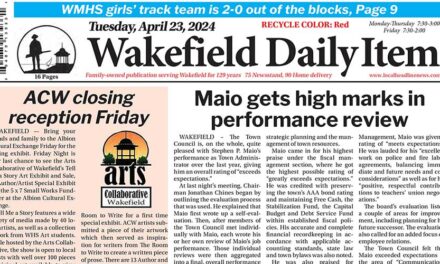Published December 9, 2020
By MARK SARDELLA
WAKEFIELD — It will be at least another month and a half before the railroad crossing at Broadway can be re-opened, Town Engineer William Renault told the Town Council this week.
The crossing has been closed since the summer for a joint construction project by National Grid, the Light Department and the the DPW. The crossing was expected to be re-opened in late October, but when Renault contacted the Federal Railroad Administration to discuss re-installing the medians and reopening the crossing, he was told that that the FRA had updated its rules and further safety measures would be required if the town wants to retain its status as a “quiet zone.”
A quiet zone is a section of a rail line at which locomotive horns are not routinely sounded as a warning when approaching road crossings. To qualify as a quiet zone, certain alternative safety measures must be in place at crossings.
The medians in the roadway approaching the crossing from both directions were one of the safety measures that allowed the town to retain its quiet zone status. Medians prevent motorists from attempting to drive around lowered crossing gates. The medians at the Broadway crossing were removed to facilitate the construction project.
Renault has been in discussions with the FRA and expects to file an amended application with the agency in the next few days to re-install the traffic medians and re-open the Broadway crossing. The FRA’s review of the application could take 30-60 days, Renault said.
If the town were to open the crossing before FRA approval is granted, it would lose its quiet zone status. Since the town was an early quiet zone adopter, it currently has a lower threshold for maintaining that status. But if the town loses its quiet zone, it would be required to re-apply under the much more stringent standards, which would require more comprehensive (and costly) measures to be installed.
Due to a serious accident at the crossing on Aug. 11, 2016, Broadway is considered the town’s most dangerous crossing, Renault said. For that reason the crossing must remain closed until the FRA is satisfied that the safety measures proposed by the town are adequate to maintain its quiet zone.
Renault hopes that the short-term measure of replacing the medians will be enough to allow the town to re-open the Broadway crossing. But he cautioned that that measure alone would get the town just below the threshold to maintain the quiet zone. A significant increase in traffic or another accident could push the town over that threshold.
So, in the longer term, Renault is suggesting installing a new “quad gate” system (four gates to block both lanes on both sides of the crossing), which under FRA standards would give the town an additional “buffer” toward retaining its quiet zone. That quad gate system could cost as much as $2 million.
Town Councilor Edward Dombroski asked if the FRA would grant any type of a hardship exception, citing the devastating effect that the closure has had on Broadway businesses.
Renault said that he had asked about that and was told that the FRA does not allow temporary measures. Only permanent construction counts toward meeting their requirements.
“We could open it tomorrow and let them blow horns,” Renault added.
Dombroski asked about calling upon the town’s congressional delegation to put pressure on the FRA. But Renault said that the FRA has been receptive and responsive thus far and recommended waiting a couple of weeks before calling in congressional support.




